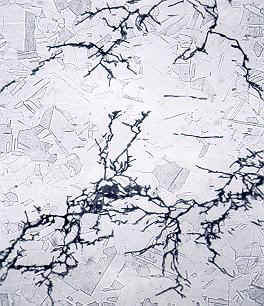| Stress Corrosion Cracking (SCC) | |
| Usually, most of the surface remains unattacked, but with fine cracks penetrating into the material. In the microstructure, these cracks can have an intergranular or a transgranular morphology. Macroscopically, SCC fractures have a brittle appearance. SCC is classified as a catastrophic form of corrosion, as the detection of such fine cracks can be very difficult and the damage not easily predicted. Experimental SCC data is notorious for a wide range of scatter. A disastrous failure may occur unexpectedly, with minimal overall material loss.
The micrograph on the right (X500) illustrates intergranular SCC of an Inconel heat exchanger tube with the crack following the grain boundaries. |
|
 | The micrograph on the left (X300) illustrates SCC in a 316 stainless steel chemical processing piping system.Chloride stress corrosion cracking in austenitic stainless steel is characterized by the multi-branched "lightning bolt" transgranular crack pattern. |
The most effective means of preventing SCC are: 1) properly with the right materials; 2) reduce stresses; 3) remove critical environmental species such as hydroxides, chlorides, and oxygen; 4) and avoid stagnant areas and crevices in heat exchangers where chloride and hydroxide might become concentrated. Low alloy steels are less susceptible than high alloy steels, but they are subject to SCC in water containing chloride ions.
Chloride SCC
One of the most important forms of stress corrosion that concerns the nuclear industry is chloride stress corrosion. Chloride stress corrosion is a type of intergranular corrosion and occurs in austenitic stainless steel under tensile stress in the presence of oxygen, chloride ions, and high temperature. It is thought to start with chromium carbide deposits along grain boundaries that leave the metal open to corrosion. This form of corrosion is controlled by maintaining low chloride ion and oxygen content in the environment and use of low carbon steels.
Caustic SCC
the extensive qualification of Inconel for specific applications, a number of corrosion problems have arisen with Inconel tubing. Improved resistance to caustic stress corrosion cracking can be given to Inconel by heat treating it at 620oC to 705oC, depending upon prior solution treating temperature. Other problems that have been observed with Inconel include wastage, tube denting, pitting, and intergranular attack.
Stress Corrosion Cracking SCC
ology Flow chart Range of Applications QUALIFICATION EQUIPMENT Producing Equipment Testing Equipment QUALITY&SERVICE Quality Control Service METALS ENGINEERING FEEDBACK CONTACT US Corrosion <span>Stress Corrosion Cracking (SCC) Usually, most of the surface remains unattacked, but with fine cracks penetrating into the material. In the microstructure, these cracks can have an intergranular or a transgranular morphology. Macroscopically, SCC fractures have a brittle appearance. SCC is classified as a catastrophic form of corrosion, as the detection of such fine cracks can be very difficult and the damage not easily predicted. Experimental SCC data is notorious for a wide range of scatter. A disastrous failure may occur unexpectedly, with minimal overall material loss. The micrograph on the right (X500) illustrates intergranular SCC of an Inconel heat exchanger tube with the crack following the grain boundaries. The micrograph on the left (X300) illustrates SCC in a 316 stainless steel chemical processing piping system.Chloride stress corrosion cracking in austenitic stainless steel is characterized by the multi-branched "lightning bolt" transgranular crack pattern. The most effective means of preventing SCC are: 1) properly with the right materials; 2) reduce stresses; 3) remove critical environmental species such as hydroxides, chlorides, and oxygen; 4) and avoid stagnant areas and crevices in heat exchangers where chloride and hydroxide might become concentrated. Low alloy steels are less susceptible than high alloy steels, but they are subject to SCC in water containing chloride ions. Chloride SCC One of the most important forms of stress corrosion that concerns the nuclear industry is chloride stress corrosion. Chloride stress corrosion is a type of intergranular corrosion and occurs in austenitic stainless steel under tensile stress in the presence of oxygen, chloride ions, and high temperature. It is thought to start with chromium carbide deposits along grain boundaries that leave the metal open to corrosion. This form of corrosion is controlled by maintaining low chloride ion and oxygen content in the environment and use of low carbon steels. Caustic SCC the extensive qualification of Inconel for specific applications, a number of corrosion problems have arisen with Inconel tubing. Improved resistance to caustic stress corrosion cracking can be given to Inconel by heat treating it at 620oC to 705oC, depending upon prior solution treating temperature. Other problems that have been observed with Inconel include wastage, tube denting, pitting, and intergranular attack. Related References: 1. austenitic stainless steel 2. Stress Corrosion Cracking SCC 3. Chloride Stress Corrosion Cracking (CLSCC) 4. Stress Corrosin Cracking SCC of Duplex Stainless Stee
Summary
| status | not read | reprioritisations | ||
|---|---|---|---|---|
| last reprioritisation on | suggested re-reading day | |||
| started reading on | finished reading on |
